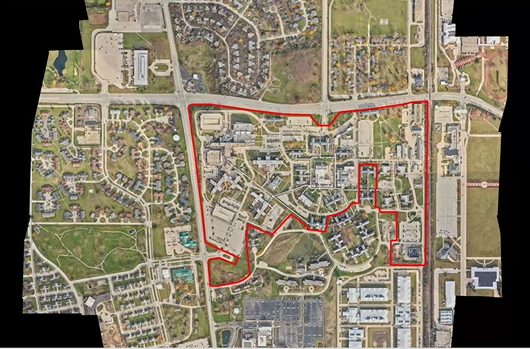James A. Lovell Federal Health Care Center (FHCC)
The James A. Lovell Federal Health Care Center (FHCC) in North Chicago, part of the U.S. Department of Veterans Affairs (VA), is a critical medical facility dedicated to serving veterans and active-duty military personnel. As one of the nation's most important healthcare resources for the military community, the FHCC provides comprehensive medical services, including emergency care, outpatient services, and specialized treatment programs. The goal of this land and utility surveying project is to provide a detailed, accurate, and comprehensive model and plans of the facility’s existing infrastructure in order to facilitate more effective asset management and more informed future planning.
SAM was chosen for this highly technical project, in part due to our expertise in 2D mapping and 3D modeling, as well as our ability to integrate the data collected through a variety of geospatial and geophysical applications into a single, multi-functional deliverable that fully encompasses this large-scale healthcare facility. The project involves conducting a comprehensive survey of the FHCC’s boundary, topography, and infrastructure, including all the buildings and underground utility systems located throughout the entire campus layout. What sets this project apart is the integration of both traditional and cutting-edge mapping technologies. SAM has deployed the latest surface geophysical equipment designed for accurately locating and mapping underground utilities, along with terrestrial LiDAR technology, which provides detailed 3D scans of the campus and its systems. This combination of advanced and traditional technologies ensures a thorough investigation, leaving no detail overlooked. The collected data will be used to generate a highly detailed and accurate 3D model of the entire site, which will serve as a valuable tool, enabling the FHCC to visualize infrastructure in a way that was not previously possible.
SAM’s team for this project is a highly skilled and diverse group, drawing expertise from multiple disciplines and offices across the country. Subsurface Utility Engineering (SUE) teams from Chicago, Denver, and Dallas have been deployed to work together, along with the Austin Aerial Mapping team, Terrestrial Mapping (Survey) teams from Chicago and Midland, Texas, and a GIS Mapping team from Maryville, Missouri. By bringing together such a talented and geographically diverse team, SAM has been able to ensure that every aspect of the project is managed with the utmost precision and expertise.
Another unique aspect of this project is the focus on the site’s self-sustaining infrastructure. While the FHCC campus is served by a dedicated traditional power substation, it also houses its own cogeneration (COGEN) plant, which, along with a number of backup generators, is a critical component in ensuring that the facility remains operational even during power outages or disruptions. The heat from the COGEN plant also produces steam, which supplements the FHCC’s heating systems. Mapping these supplemental electrical power and heating support systems is an essential part of the project and helps to ensure that these systems are fully integrated into the asset management model, supporting the VA’s efforts to maintain a resilient, efficient, and sustainable facility.

Throughout the project, SAM has demonstrated an exceptional ability to collaborate with various stakeholders, including the FHCC’s on-site facilities management team. Close coordination with the facilities management staff has been essential in ensuring smooth investigative and data collection operations in the field. SAM's team has worked closely with these experts to navigate the challenges posed by the campus’s large size and complex utility systems. These collaborations have allowed SAM to gain a deeper understanding of the existing infrastructure and will, in turn, allow the VA to more effectively plan for and implement future upgrades and additions with minimal disruption to the ongoing operations of the medical center.
The combination of efficient use of resources, cutting-edge technology, and a highly skilled team has made it possible to maintain budget discipline while ensuring the highest level of quality and precision throughout the project. The project is on track to be completed in July 2025, with SAM committed to ensuring that all goals are met on time. Proactive planning and careful project management have played key roles in keeping the project on track.

